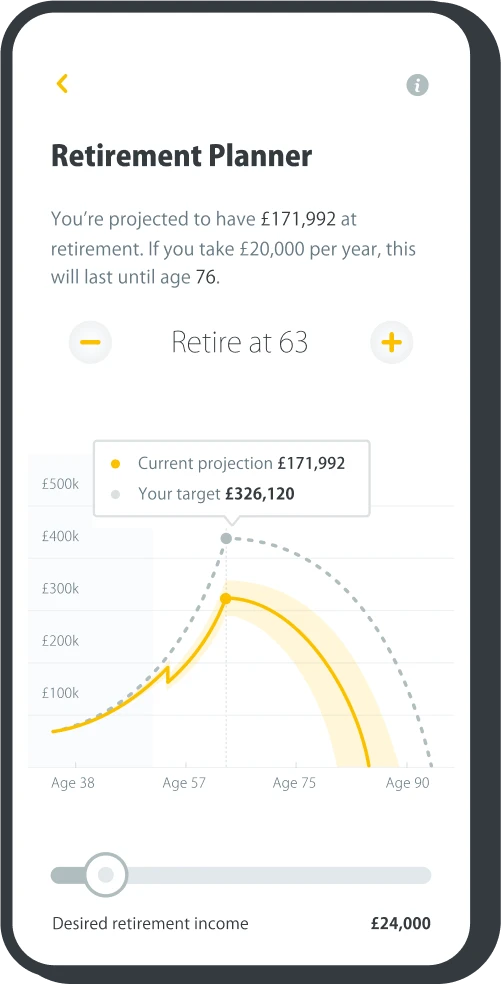Featured articles
How to start investing
If you’re not familiar with investing, it can feel daunting knowing where to start. This article walks you through the basics to help you understand what it is, how it differs from saving and what types of investing there are.
Investing vs. saving
Investing carries greater risk than saving, as your investments can go up or down in value over time. However, it also offers the chance for your money to grow more significantly over time. Investing could mean putting your money into assets like company shares or property.
Whereas saving involves setting aside money in a bank account. Savings products and accounts are a typically low-risk way to grow your money. You can generally expect to get back what you originally saved, plus some extra, usually in the form of interest.
What types of investments are there?
Some of the most common types of investment include:
Company shares (also known as stocks or equities)
The stock market is where publicly traded companies are bought and sold. So, investing in stock means you’re purchasing and owning a small part of a company. If the value of the company grows or falls, then so too would the value of the stock you bought.
Property
Investing in property can involve buying a physical property to sell or rent, or investing in a property fund (more on this later see ‘How to start investing in property’).
Mutual Funds & Exchange Traded Funds (ETFs)
These take money from multiple investors and invest in a mix of different things, like stocks and bonds.
Bonds
Often described as an IOU, you’re essentially lending your money to a government or business. In return, you’ll get your money back plus interest payments on top of it.
Alternative assets
These are typically considered investments that aren’t cash, bonds, or stocks. These could include luxury goods such as fine art or collectables like watches. Or, commodities like physical gold, among other asset types.
Benefits of investing
- Potential for higher returns compared to savings - this could help you reach long-term financial goals like saving for a deposit on a house or retirement.
- Potential to offset the rate of inflation - this could help maintain or increase your money’s purchasing power in the future.
- You could benefit from compound growth - where you earn interest on top of your initial investment, plus any interest already earned. The earlier you start investing, the more time you have for your investment to grow from compounding.
- Diversifying opportunities - putting your money into different types of investments can help reduce the risks associated with investing (more on this later).
Risks of investing
The biggest risk is that you could get back less than you originally invested. Investing is less predictable than saving, and returns aren’t guaranteed.
Changes in the stock market, for example, can reduce the value of an investment. Negative changes can be a result of economic factors like an increase in inflation or changes in government regulation, among others.
Getting started with investing
You don’t need to be wealthy or have expert knowledge to start investing. With new financial apps lowering the barriers to entry, investing is becoming increasingly accessible to more people.
However, there are some important considerations to make before you decide to invest.
Deciding on your financial goals
Have a clear idea of what you’d like to use your investment for. Examples include income for retirement, helping to buy or improve your home or providing for your child’s education.
Building a separate emergency fund
An emergency fund is a pot of money you set aside and only access to cover an unexpected expense, like an urgent home repair. This could help you avoid having to withdraw money from your investment, which allows it to continue to grow. It’s generally recommended to have around 3-6 months of living expenses in your emergency fund.
Understanding your risk tolerance
Risk tolerance is the amount of loss in your investments you’re prepared to accept. All investments come with some risk, so it’s always possible you may get back less money than you invest.
A golden rule of investing is to avoid investing more than you can afford to lose.
Start small, start early
You don’t need a large amount of money to get started with investing or even have expert knowledge. You might prefer to start with investing a small amount and gradually increasing your investment as you become more comfortable with how it works.
Review your investments
It’s important to regularly review your investments to make sure they’re on track to meet your financial goals. If your circumstances or goals change, you may need to make adjustments.
Be aware of fees
Investing can incur multiple fees that could erode the value of your investment over time. These could include platform fees, account management fees and trading fees, among others.
Diversification
If you diversify your investments, you put your money into a mix of different assets. For example, investing some money in stocks and some in bonds. This helps spread the risk, so if one investment loses value, it’s less likely to impact the total value of all your investments. It’s often thought of as avoiding putting all your eggs into one basket.
Be pension confident.
Combine your old pension pots into one new online plan. It takes just a few minutes to sign up.
Get startedHow to start investing in stocks
Here are some things to think about when considering investing in stocks.
Pooled investments
Investing in an index fund means spreading your investment across many companies. This helps diversify your investment and reduces risk; if one investment loses value, others might hold or grow their value.
Stock picking
Investing in individual stocks of different companies. This approach usually requires more research and knowledge to understand which companies to invest in. This can be higher risk as performance relies on a smaller number of companies performing well compared with a pooled investment.
Stocks and Shares ISA
A Stocks and Shares ISA is a tax-efficient way of investing in a wide range of assets, but without the need to pay Income Tax or Capital Gains Tax (CGT) on your investment. However, there’s a limit to how much you can save each tax year. For the 2025/26 tax year, you invest up to £20,000 without paying Income Tax or CGT on any money you might make from your investment.
Active vs. passive management
Most funds are passively managed. They involve automatically tracking and trying to replicate the performance of an existing index. An example of an index is the S&P 500, which tracks the performance of 500 of the largest publicly traded companies in the US.
Actively managed funds involve a fund manager choosing which companies to invest your money in, aiming to outperform the market. These typically come with higher fees.
Choosing how to invest
There are a variety of investment methods, from online brokers to robo-advisors. Here’s how they differ.
Brokerages
These come in two forms: traditional brokers and online brokers. A traditional brokerage will typically offer more personalised guidance on how you might want to invest, as well as manage your investment on an ongoing basis. An online brokerage enables you to invest in stocks via a website or mobile app at the click or tap of a button. They usually have lower fees compared to a traditional brokerage, but often lack someone to talk to directly for support.
Robo advisors
These are automated online platforms that invest your money based on your answers to a series of questions. These include things like your financial goals and risk tolerance. There isn’t usually any human interaction. Instead, a computer algorithm is used to understand how you want to invest and manage your investment for you.
How to start investing in property
Investing in property could provide you with regular returns. But it can also come with costs like building maintenance and taxes. There are different ways to invest in property. Whichever you choose, it’s always a good idea to do your research. For example, the types of property that might be a good investment, looking at market trends and location.
Buying a property to sell or rent
When buying a physical property to invest in, there are two options. You could:
- buy it with a view to increasing the value and selling it in future; or
- let it out to provide rental income.
Some people choose to improve the property to increase its sale or rental value. This comes with the responsibility of managing the property and any related costs.
Investing in property funds
These funds work by pooling and investing money from multiple investors into the property market. A fund might invest in residential homes or commercial property, like offices or retail spaces. Alternatively, it could invest in shares of companies related to property or combine these two approaches.
Investing in a pension
A pension is a financial product designed to help support you when you stop working by providing a regular income. There are three main types of pension in the UK.
Personal pension
This is one you can set up for yourself with a private pension provider like PensionBee. An employer won’t typically contribute to a personal pension, though you can ask them to. The money you pay into the pension plan you choose is invested. The performance of your pension is dependent on things like how much you contribute to it, plan management fees and how your plan’s investments have performed.
Workplace pension
A workplace pension is provided by an employer. To be eligible, you need to be aged between 22 and State Pension age and earn at least £10,000. Most employees will be eligible for automatic enrolment in their employer’s pension scheme. There are two types of workplace pensions, defined contribution and defined benefit. As with a personal pension, the money you pay into your employer’s pension scheme is also invested.
State Pension
The State Pension is a regular payment from the government. Unlike a personal or workplace pension, the State Pension isn’t invested. The amount you receive and when you can get it depend on things like your National Insurance contributions (NICs) and when you were born.
Benefits of investing in a pension
Tax benefits
One of the biggest benefits of investing in a pension is the tax relief you can get from the government. Most basic rate taxpayers get a 25% tax top up on their personal contributions, meaning HMRC usually adds £25 for every £100 you pay into your pension. Higher and additional rate taxpayers can usually claim back extra through Self-Assessment.
This can be a powerful way to grow your pension over the long term, especially when combined with the effect of compounding. The earlier you contribute, the more time your pension has to benefit from compounding and tax relief.
Potential for long-term growth
The State Pension is unlikely to provide a sufficient income to live on in retirement. Personal and workplace pensions typically invest your money to grow it over the long term and build a pension to support you financially in retirement. However, the value of your investment can go down as well as up, and you may get back less than you invested.
Plans like our Global Leaders Plan invest only in company stocks. Others invest in a mix of assets, like our Tracker Plan, which invests in both stocks and bonds. Find out more about our plans.
Employer contributions
When you’re in a workplace pension scheme, you’ll usually benefit from pension contributions from your employer alongside contributions you make.
Read more about pension investments.
Risk warning
As always with investments, your capital is at risk. The value of your investment can go down as well as up, and you may get back less than you invest. This information should not be regarded as financial advice.
Last edited: 02-07-2025







